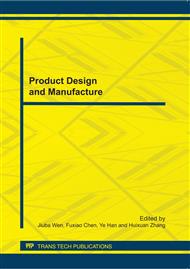[1]
X.B. Shan, T. Xie, W.S. Chen, L.L. Wang. Modeling and experimental verification of the axial stiffness for a wire race ball bearing. IASTED International Conference on Modelling, Simulation, and Identification, October 12-14, 2009, Beijing, China. Acta Press (2009)
Google Scholar
[2]
X.B. Shan, L.L. Wang, T. Xie, W.S. Chen, A simple approach for determining the preload of a wire race ball bearing, Journal of Zhejiang University-Science A. 11 (2010) 511-519
DOI: 10.1631/jzus.a0900583
Google Scholar
[3]
J.M. De Mul, J.M. Vree, D.A. Maas, Equilibrium and associated load distribution in ball and roller bearings loaded in five degrees of freedom while neglecting friction---Part I: general theory and application to ball bearings, Journal of Tribology. 111 (1989) 142-148
DOI: 10.1115/1.3261864
Google Scholar
[4]
M.A. Al-Shudeifat, E.A. Butcher, C.R. Stern, General harmonic balance solution of a cracked rotor-bearing-disk system for harmonic and sub-harmonic analysis: analytical and experimental approach, International Journal of Engineering Science. 48 (2010) 921-935
DOI: 10.1016/j.ijengsci.2010.05.012
Google Scholar
[5]
Y.Z. Cao, Y. Altintas, A general method for the modeling of spindle-bearing systems, Journal of Mechanical Design. 126 (2004) 1089-1104
DOI: 10.1115/1.1802311
Google Scholar
[6]
M.N. Sahinkaya, A.H.G. Abulrub, P.S. Keogh, C.R. Burrows, Multiple sliding and rolling contact dynamics for a flexible rotor/magnetic bearing system, Mechatronics, IEEE/ASME Transactions on. 12 (2007) 179-189
DOI: 10.1109/tmech.2007.892827
Google Scholar
[7]
B. Jacobson, The Stribeck memorial lecture, Tribology International. 36 (2003) 781-789
DOI: 10.1016/s0301-679x(03)00094-x
Google Scholar
[8]
K. Willner, Elasto-plastic normal contact of three-dimensional fractal surfaces using halfspace theory, Journal of Tribology. 126(2004) 28-33
DOI: 10.1115/1.1631019
Google Scholar
[9]
J.A. Williams, The influence of repeated loading, residual stresses and shakedown on the behaviour of tribological contacts, Tribology International. 38 (2005) 786-797
DOI: 10.1016/j.triboint.2005.02.006
Google Scholar
[10]
A. Almqvist, F. Sahlin, R. Larsson, S. Glavatskih, On the dry elasto-plastic contact of nominally flat surfaces, Tribology International. 40 (2007) 574-579
DOI: 10.1016/j.triboint.2005.11.008
Google Scholar


